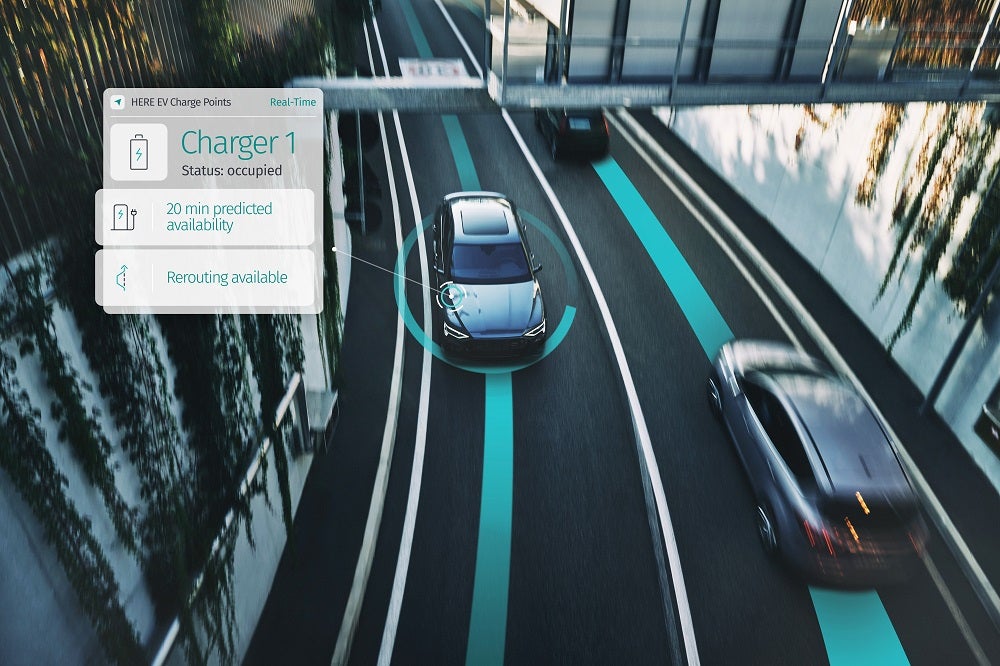
For EV drivers, range anxiety – the fear that an EV will run out of available battery charge before reaching its destination – is one of several pain points for the industry. For private car drivers, the most convenient solution is an onboard API (Application Programming Interface) service that tells you not only where the next charge point is, but also if it is working and available at the time you need it.
With sales of EVs doublingi in 2021 from the previous year, hitting 6.6 million worldwide, the amount of public charging infrastructure that has been announced may be insufficient to power the size of the EV market being targeted.
Predictive availability could support an interim solution; helping charging infrastructure by managing pain points at high use locations and by incorporating EV infrastructure supply and real-world user demand, including traffic and weather patterns.
HERE’s innovative proprietary machine learning model, leverages years of experience analysing vehicle sensor data, traffic patterns and correlations. By integrating specific routing that helps maximize vehicle energy efficiency and advance planning for charging stopovers, HERE helps mitigate range anxiety for users, allowing for longer, multi-charge journeys.
Much-needed tool for EV drivers
Chris Handley, Vice President, Dynamic and Spatial Content at HERE Technologies, says predictive technology addresses range anxiety and highlights solutions to current pain points for the industry.
“To provide a higher level of value to drivers we need to know what is going to happen in the future,” says Handley. “First is predictive traffic, so understanding what traffic is going to be like tomorrow.” Unlike using a historical average, predictive traffic software uses actual data sets, utilising range and routing.
“The second area we are developing, is services in the EV space. Prediction on the likelihood that a charge point is going to be available and working at some point in the future as an input into a routing decision. This may be an hour from now, or if you’re going on a longer journey, maybe tomorrow. What this means is that when you get there you have a higher degree of confidence that the charge point is going to be available.”

Handley points out that range anxiety is seen by users as a core issue for EV: “If a user gets to a charge point with a plan to recharge and the charge point is not working – which is an issue reported in 14.4% of US charge pointsii – and there’s a long line of other drivers who are waiting to recharge… it’s then forcing the driver to go and try to find another charge point, which may be 20 minutes back in the direction they came from or might not be within the charging network.
“In worst cases, it might be out of their range. At HERE we are trying to alleviate that concern by providing additional information that allows more intelligent routing decisions, updated enroute. If a charge point you were planning to reach along the route suddenly becomes unavailable, say because a bunch of other people have shown up, that would be considered by the system which could reroute you to another one that has a higher likelihood (of availability) before you arrive. That’s what we mean by prediction.”
HERE EV Charge Points
Launched at Las Vegas, CES 2023, HERE EV Charge Points’ availability prediction featureiii is powered by an applied Machine Learning (ML) algorithm that weights GPS probes, vehicle sensor data and correlated historical time/day, weather, and traffic pattern data, enabling a granular view of EV charge point user patterns and surrounding traffic conditions.
HERE location data and software services are already used in 170 million vehicles globally with the platform using live sensor data from an estimated 34 million connected vehicles to power its connected and automated vehicle services, such as Advanced Driver Assistance Systems (ADAS).
“Overlaying that, we’re using machine learning to analyse the correlated data sets that drive occupancy (of the charge point),” explains Handley, “by asking questions of the data. How does occupancy change with the bank holiday or not? How does occupancy change with traffic levels? How does occupancy change with weather or nearby events? And we use those data sources to create a prediction. That is beyond just having a typical time series for when it is occupied.”
This volume of real-world data provides a virtuous loop of ML training data for HERE to continually improve the prediction service, and with increased usage, that model is trained and becomes more accurate over time.
Predictive technology and the wider EV sector
After providing drivers with this valuable product, Handley says that over time, this data could be useful to infrastructure planning too: “After we accumulate data around these different charge points, usage, occupancy, and so on, that will be information we will provide to public planning authorities and utilities, to help with their own planning efforts as to where to open charge points.”
Other opportunities include facilities for drivers looking for amenities near to charge points, such as pharmacies, grocery stores, or hotels.
“We see a lot of investment dollars today from governments and tax subsidies,” comments Handley. “In North America, the forecast for charge point networks becoming availableiv is well behind the forecast for EV vehicle sales. So, there are going to be pain points. As we start to address those problems, as those services get rolled out to the users, they talk to their friends, industry starts to catch up, these become key selling points for electric vehicles.”
“Ultimately what we’re looking to do is to reduce the barriers to adoption of EV and one of the biggest is range anxiety. So, the more precise we can become on that range forecast, and the more precise we can become on planning for a recharge event, the more we’re going to be able to reduce that. We believe that’s going to accelerate the proliferation of EV vehicles.”
To find out more about HERE’s predictive technology please click on the whitepaper below.
[i] https://www.iea.org/reports/global-ev-outlook-2022/executive-summary
[ii] https://www.bloomberg.com/news/articles/2022-08-17/the-ev-charging-buildout-has-a-problem-many-stations-don-t-work?leadSource=uverify%20wall
[iii] https://www.here.com/about/press-releases/en/here-unveils-new-service-that-predicts-availability-of-ev-charge-points
[iv] https://www.wsj.com/articles/ev-charging-stations-electric-vehicles-11669737656


